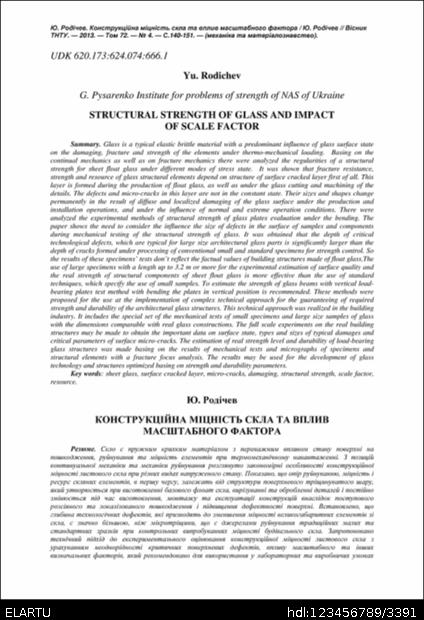Empreu aquest identificador per citar o enllaçar aquest ítem:
http://elartu.tntu.edu.ua/handle/123456789/3391

| Títol: | Конструкційна міцність скла та вплив масштабного фактора |
| Altres títols: | Structural strength of glass and impact of scale factor |
| Autor: | Rodichev, Yu. |
| Bibliographic description (Ukraine): | Родічев Ю. Конструкційна міцність скла та вплив масштабного фактора / Ю. Родічев // Вісник ТНТУ — Тернопіль : ТНТУ, 2013. — Том 72. — № 4. — С 140-151. — (механіка та матеріалознавство). Rodichev Yu. Structural strength of glass and impact of scale factor / Yu. Rodichev // Bulletin of TNTU — Ternopil : TNTU, 2013. — Volume 72. — No 4. — P 140-151. — (mechanics and materials science). |
| Data de publicació: | 19-de -2013 |
| Date of entry: | 3-de -2014 |
| Editorial: | Тернопiльський національний технiчний унiверситет iменi Iвана Пулюя |
| Place of the edition/event: | Тернопіль |
| UDC: | 620.173 624.074 666.1 |
| Paraules clau: | листове скло поверхневий тріщинуватий шар мікротріщини пошкодження конструкційна міцність масштабний фактор ресурс sheet glass surface cracked layer micro-cracks damaging structural strength scale factor resource |
| Resum: | Cкло є пружним крихким матеріалом з переважним впливом стану поверхні на
пошкодження, руйнування та міцність елементів при термомеханічному навантаженні. З позицій
континуальної механіки та механіки руйнування розглянуто закономірні особливості конструкційної
міцності листового скла при різних видах напруженого стану. Показано, що опір руйнуванню, міцність і
ресурс скляних елементів, в першу чергу, залежать від структури поверхневого тріщинуватого шару,
який утворюється при виготовленні базового флоат скла, вирізуванні та обробленні деталей і постійно
змінюється під час виготовлення, монтажу та експлуатації конструкцій внаслідок поступового
розсіяного та локалізованого пошкодження і підвищення дефектності поверхні. Встановлено, що
глибина технологічних дефектів, які призводять до зменшення міцності великогабаритних елементів зі
скла, є значно більшою, ніж мікротріщини, що є джерелами руйнування традиційних малих та
стандартних зразків при контрольних випробуваннях міцності будівельного скла. Запропоновано
технічний підхід до експериментального оцінювання конструкційної міцності листового скла з
урахуванням неоднорідності критичних поверхневих дефектів, впливу масштабного та інших
визначальних факторів, який рекомендовано для використання у лабораторних та виробничих умовах
для забезпечення належної міцності та ресурсу великорозмірних будівельних конструкцій. Обгрунтовано
необхідність збільшення довжини зразків флоат скла до 3,2 м та більше, щоб підвищити достовірність
прогнозування міцності та ресурсу великорозмірних будівельних конструкцій. Для оцінювання міцності
скляних балок з вертикальним розташуванням несівних пластин рекомендовано метод випробування
пластин на згин у вертикальному положенні. Glass is a typical elastic brittle material with a predominant influence of glass surface state on the damaging, fracture and strength of the elements under thermo-mechanical loading. Basing on the continual mechanics as well as on fracture mechanics there were analyzed the regularities of a structural strength for sheet float glass under different modes of stress state. It was shown that fracture resistance, strength and resource of glass structural elements depend on structure of surface cracked layer first of all. This layer is formed during the production of float glass, as well as under the glass cutting and machining of the details. The defects and micro-cracks in this layer are not in the constant state. Their sizes and shapes change permanently in the result of diffuse and localized damaging of the glass surface under the production and installation operations, and under the influence of normal and extreme operation conditions. There were analyzed the experimental methods of structural strength of glass plates evaluation under the bending. The paper shows the need to consider the influence the size of defects in the surface of samples and components during mechanical testing of the structural strength of glass. It was obtained that the depth of critical technological defects, which are typical for large size architectural glass parts is significantly larger than the depth of cracks formed under processing of conventional small and standard specimens for strength control. So the results of these specimens’ tests don’t reflect the factual values of building structures made of float glass.The use of large specimens with a length up to 3.2 m or more for the experimental estimation of surface quality and the real strength of structural components of sheet float glass is more effective than the use of standard techniques, which specify the use of small samples. To estimate the strength of glass beams with vertical load- bearing plates test method with bending the plates in vertical position is recommended. These methods were proposed for the use at the implementation of complex technical approach for the guaranteeing of required strength and durability of the architectural glass structures. This technical approach was realized in the building industry. It includes the special set of the mechanical tests of small specimens and large size samples of glass with the dimensions comparable with real glass constructions. The full scale experiments on the real building structures may be made to obtain the important data on surface state, types and sizes of typical damages and critical parameters of surface micro-cracks. The estimation of real strength level and durability of load-bearing glass structures was made basing on the results of mechanical tests and micrographs of specimens and structural elements with a fracture focus analysis. The results may be used for the development of glass technology and structures optimized basing on strength and durability parameters. |
| URI: | http://elartu.tntu.edu.ua/handle/123456789/3391 |
| ISSN: | 1727-7108 |
| Copyright owner: | © „Вісник Тернопільського національного технічного університету“ |
| Content type: | Article |
| Apareix a les col·leccions: | Вісник ТНТУ, 2013, № 4 (72) |
Arxius per aquest ítem:
| Arxiu | Descripció | Mida | Format | |
|---|---|---|---|---|
| TNTUB_2013v72n4_Yu_Rodichev-Structural_strength_of_140-151.pdf | 648,37 kB | Adobe PDF | Veure/Obrir | |
| TNTUB_2013v72n4_Yu_Rodichev-Structural_strength_of_140-151.djvu | 324,72 kB | DjVu | Veure/Obrir | |
| TNTUB_2013v72n4_Yu_Rodichev-Structural_strength_of_140-151__COVER.png | 200,87 kB | image/png | Veure/Obrir |
Els ítems de DSpace es troben protegits per copyright, amb tots els drets reservats, sempre i quan no s’indiqui el contrari.